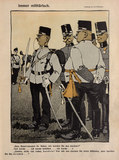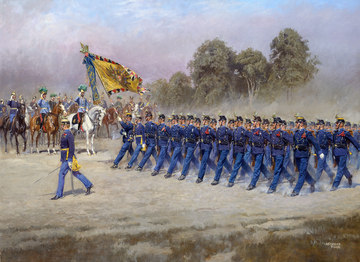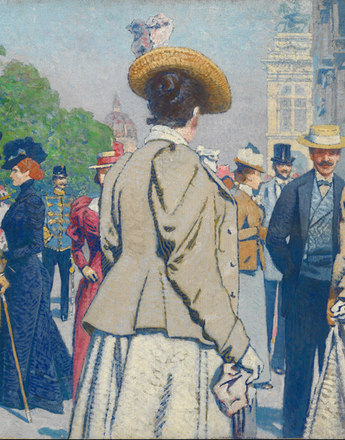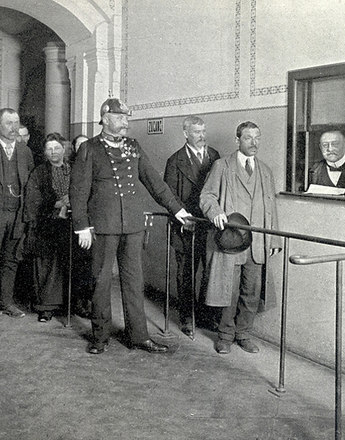-

Fritz L’Allemand: Emperor Franz Joseph on the garden steps at Schönbrunn Palace on the occasion of the 100th anniversary of the Order of Maria Theresa, oil painting, 1857
Copyright: Schloß Schönbrunn Kultur- und Betriebsges.m.b.H.
Partner: Schloss Schönbrunn Kultur- und Betriebsges.m.b.H. -

Wilhelm Gause: Lästerallee in the Prater, painting, around 1895
Copyright: Wien Museum
-

Changing of the guard at the Palace, short film, around 1900
Copyright: Österreichische Mediathek
Partner: Österreichische Mediathek -

Ludwig Koch: The Supreme Commander of the Army, Emperor Franz Joseph I, illustration, 1907
Copyright: Schloß Schönbrunn Kultur-und Betriebsges.m.b.H./Fotograf: Alexander E. Koller
Partner: Schloß Schönbrunn Kultur- und Betriebsges.m.b.H. -

Fritz Schönpflug : “Always military”, caricature from Die Muskete of 21 May 1908
Copyright: ÖNB/ANNO
Partner: Austrian National Library
The famous words ‘In deinem Lager ist Österreich’ from the poet Franz Grillparzer’s eulogy to Field Marshal Radetzky celebrate the Imperial and Royal Army as the supreme embodiment of the Habsburg Monarchy: ‘There in your encampments, behold her: Austria!’. Nor did the uniformly white-coated soldiers of the multi-ethnic army serve the state: they served Emperor Franz Joseph, who was ‘Supreme War Lord’.
‘My army is joint [Austro-Hungarian] and unified and that is how it is to stay!’
Franz Joseph was a ‘soldier-emperor’. After all, he had the army to thank for enabling him to impose his rule during the revolution of 1848. The Emperor saw himself first and foremost as a soldier and constantly emphasized his close connection with the armed forces through his personal appearance, donning military uniform on a daily basis. Not for nothing do most official portraits show him in uniform.
Like the Emperor himself, the Army was a symbol of the Monarchy as a whole and retained this character even after the Austro-Hungarian Compromise of 1867. The ‘Common Army’, to use the correct term for the joint ground forces of the Dual Monarchy, was under the direction of the Imperial and Royal War Ministry (from 1911 ‘Reich War Ministry’), which was likewise a common institution, with a specific key being used to share out the expenses of the army between the two halves of the Monarchy.
In order to guarantee a certain minimum level of communication the language of command and service was German, in which every soldier, regardless of his mother tongue or local dialect, had to master a standard list of orders.
The question of the nationalities affected the army just as it did all spheres of the Monarchy. When, around the turn of the century, the army was reorganized, Hungary called for the introduction of Hungarian as a language of command in addition to German and a serious internal political crisis flared up over Franz Joseph’s strict refusal of anything suggesting federalization tendencies within his army.
Emperor Franz Joseph was actively concerned to keep the civil and military administration strictly separate. Parliament’s influence on army affairs was small, being restricted to laying down the military budget and approving the numbers of new recruits. On the other hand, however, the army was a major agent of internal security: the garrisons located all over the Monarchy were outposts of the central state, which in times of crisis could use army units to demonstrate its strength in the escalating conflicts with the nationalities.
The army’s image of itself was marked by an awareness of its special status, which manifested itself in a particular code of honour and certain manners and forms of etiquette. The army was in evidence everywhere, with military uniform being a standard feature of urban life. The elegant officer – the ‘dashing lieutenant’ – was a familiar type in Austrian literature, creating an idealized image that may arouse feelings of nostalgia today but also had its darker sides. Most subalterns only enjoyed a limited degree of financial security, though this was to some extent compensated for by their social standing as officers. After a certain number of service years, for example, officers had the right to a modest noble title, and after twelve years junior officers had the right to permanent employment in the civil service.
The army was a society separate from other social spheres. Many military men came from long-standing officer families that moved from garrison to garrison and based their sense of identity and self-esteem solely upon the ideal of service to the Emperor. Because of its supranational orientation, the officer corps saw itself principally as representing the Monarchy as a whole, though it did in part display a certain susceptibility to German nationalism.
Many factors raised the prestige of the army in the eyes of the general public. In the schools military discipline was celebrated as an ideal to be emulated, with physical education being oriented in no small measure towards fitness for military service. The soldier’s life was regarded as the ideal of manliness.
For many young men from the provinces recruitment opened a door to a new and different world. It enabled them to escape from the narrowness of village life and to experience a relaxation of the rigid social and national dividing lines that characterized civilian society. The army offered them a new identity strengthened by esprit de corps and introduced them to the solidarity that went with being comrades in arms; and they also enjoyed the privilege of wearing the Austro-Hungarian army’s magical uniforms. For many, military service was a thoroughly positive experience.
Many others, however, were broken by the soulless drill and the degrading ‘licking into shape’ that were the grim reality of the soldier’s life. The suicide rate in the Austro-Hungarian Army was the highest in Europe: statistically, it has been established that there were 10.5 suicides per 10,000 men of the old Austrian army, while the rate in the German army stood at ‘only’ 2.6.
Translation: Peter John Nicholson
Hanisch, Ernst: Der lange Schatten des Staates. Österreichische Gesellschaftsgeschichte im 20. Jahrhundert [Österreichische Geschichte 1890–1990, hrsg. von Herwig Wolfram], Wien 2005
Leidinger Hannes/Moritz, Verena: Der Erste Weltkrieg, Wien [u.a.] 2011
Moritz, Verena/Leidinger, Hannes: Oberst Redl. Der Spionagefall. Der Skandal. Die Fakten (2. Aufl.), St.Pölten [u.a.] 2012
Rauchensteiner, Manfried: Österreich-Ungarn und der Erste Weltkrieg 1914–1918, Graz 1998
Traum und Wirklichkeit. Wien 1870–1930. Katalog der 93. Sonderausstellung des Historischen Museums der Stadt Wien 1985, Wien 1985
Wandruszka, Adam (Hrsg.): Die Habsburgermonarchie 1848–1918, Band V: Die bewaffnete Macht, Wien 1997
Das Zeitalter Kaiser Franz Josephs – 2. Teil: 1880–1916. Glanz und Elend. Katalog der Niederösterreichischen Landesausstellung auf Schloss Grafenegg 1987, Wien 1987
-
Chapters
- ‘God preserve Him, God protect Him’ – The Emperor
- The Army: Austria-Hungary in its entirety
- The bureaucracy as the long arm of the state
- The Dual Monarchy: two states in a single empire
- ‘Indivisible and inseparable’ – the supranational state
- The Habsburg Monarchy in the process of democratization
- The absence of political culture
- A strong monarch and autocratic tendencies



